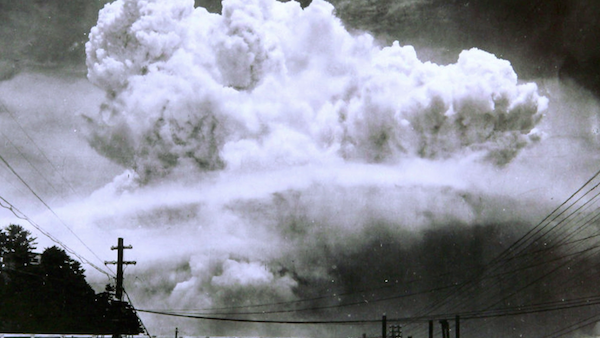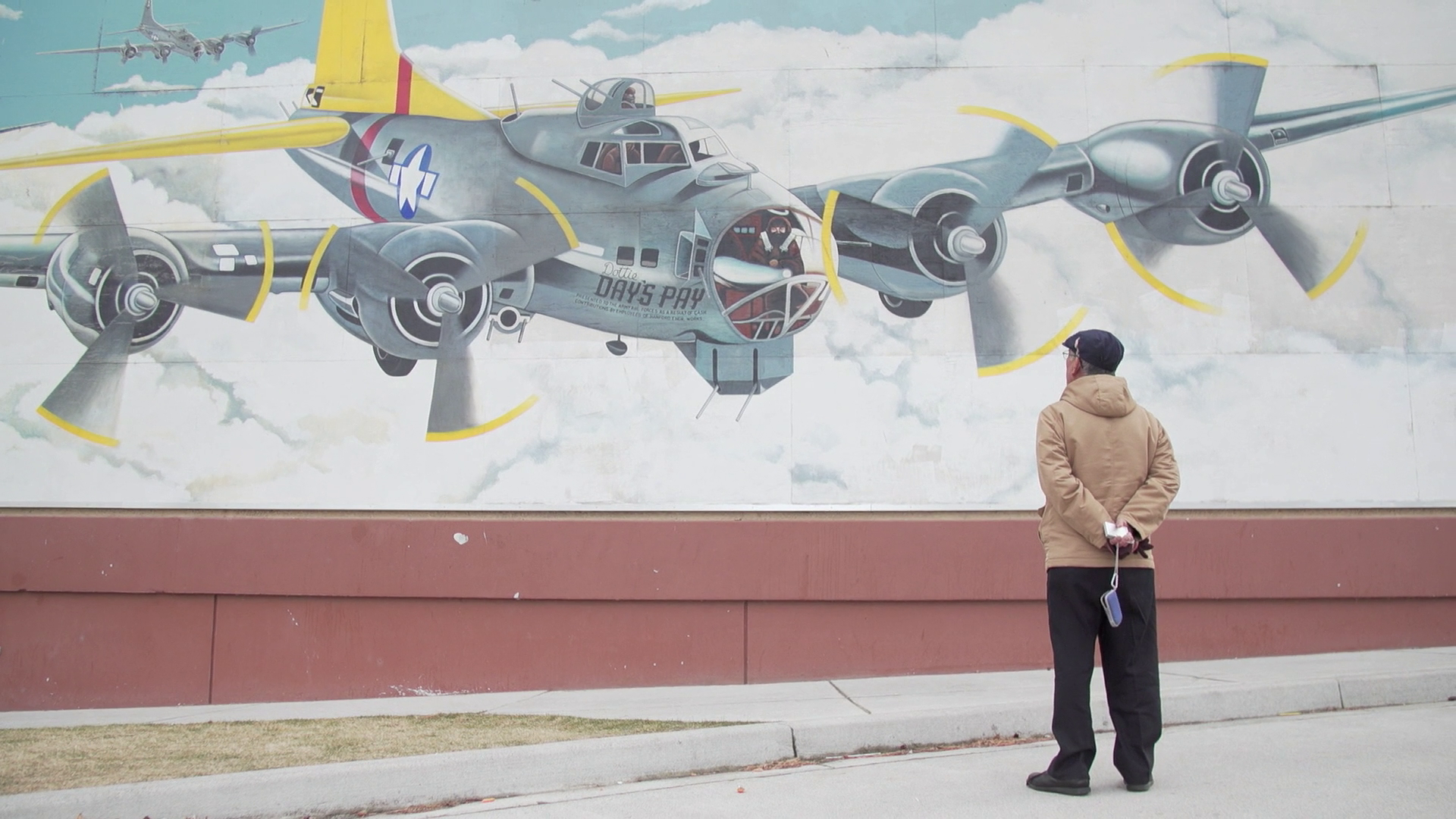Of the thousands of people who have toured giant and forbidding B Reactor, the world’s first large scale plutonium reactor, Mitsugi Moriguchi is the first person to do so in a white radiation-blocking jumpsuit, hood and mask. It is a startling sight that is perhaps less surprising when you learn why this 81-year-old is so concerned about radiation exposure: He experienced the business end of that Nagasaki bomb. Moriguchi is a hibakusha — Japanese for survivors of the bombings of Nagasaki and Hiroshima. He is thought to be the first Nagasaki hibakusha who has visited the place that created the plutonium that destroyed his city.
“I came here because I wanted to know what the town that produced plutonium is doing today,” Moriguchi said through an interpreter. “And what it plans to go on doing in the future.” Moriguchi has long wanted to see B Reactor, the world’s first large scale plutonium reactor and he brought the radiation-blocking jumpsuit for that tour. But he also hoped to see Richland, the once-secret city that was built in a hurry to house the scientists and secretaries, engineers and electricians who helped build the Fat Man bomb.
This visit was organized by two Japanese-American professors who are members of the nonprofit group Consequences of Radiation Exposure. It was paid for, in part, by Nagasaki, a city that has advocated for a nuclear weapons ban on the world stage. The travelers from Nagasaki also included a TV crew from NHK, Japan’s public broadcasting network.

The timing of this visit is no accident. It comes as America creates content for a new national park dedicated to the development of the world’s first atomic bombs at Hanford, Los Alamos and Oak Ridge. Question is, whose story will it tell?
“We learned it was going to become a national park and we in Nagasaki are quite worried. Was it going to become a national park to express pride?” Moriguchi wondered. “Or to promote reflection?”
The Japanese delegation’s first taste of Richland didn’t offer much in the way of reflection: “Bomber pride” was on full display at Atomic Ale Brewpub. While the NHK crew filmed a mannequin dressed in a gas mask and an “Oppenheimer Oatmeal Stout” sweatshirt, Moriguchi’s finger traced down the menu as he tried to sound out some of the eye-popping offerings. “Plutonium Porter? Half-life Hefeweizen?” he asked with equal notes of amusement and amazement.
His mood became more somber at the next stop, Richland High School, known as the “Home of the Bombers.” He learned that the school has two mascots, a B-17 bomber that Hanford workers donated called “Day’s Pay” and a mushroom cloud. “Shocked,” he muttered as he watched kids play basketball on a gym floor emblazoned with a mushroom cloud under a banner that read “Proud of the Cloud! Go Bombers.”
Moriguchi, himself a teacher for 40 years, tried to explain to students why he didn’t think a mushroom cloud was a proper mascot for any school, especially on a gym floor. “Under the mushroom cloud people died,” he said. “So it is like stepping on graves. I can’t forgive that.”
“What he doesn’t understand is how much the Day’s Pay and the mushroom cloud mean to us,” said student Ryan Piper. “It means where we were and where we are going. I’m sure it brings back some bad stuff but there you go.”
As Shakespeare put it, there’s the rub. In Richland and Hanford plutonium is patriotic — it fueled the bomb that, in the general U.S. telling, gave the allies a victory in World War II. The narrative told in Richland can be summed up by a video shown before the B Reactor tour: It ends with the Nagasaki mushroom cloud which the announcer says is, “one of the marvels of the 20th century.”
From Moriguchi’s perspective, plutonium is death and his visit to Richland triggered memories so strong, he cried as he described walking across Nagasaki with his mother a few days after the bomb. He was 8 years old. “There was nothing there,” he said gesturing and looking out as if he still saw the vaporized neighborhoods. “But there was smoke rising here and there. It was the smoke of the cremated bodies of those who died.”

No one in his family was among the estimated 70,000 citizens killed by the Nagasaki bomb. People called them “lucky”. But over time, the family’s luck ran out. Moriguchi’s brother and his bride, who had both been near ground zero when the bomb exploded, tried to have children. “After they were married they had a baby. Only it wasn’t a baby. It was a lump of flesh. The first two came out like that.”
Moriguchi’s oldest sister was the first to get sick. “Breast cancer, colon cancer, uterine cancer, her whole body was ravaged,” Moriguchi remembered. “She was in pain, so much pain. And she died in great anguish.”
Moriguchi believes radiation caused the cancers that killed five of his six siblings. While that can’t be proven, it is certain that Nagasaki’s radiation came from plutonium that was made at Hanford and possibly in B Reactor. Which helps explain why Moriguchi and the two professors put on Tyvek suits, masks and booties before they got on the bus that brought them to a private reactor tour. The suits block radiation. Concerns about radiation also prompted the Japanese public broadcasting organization NHK to order its crew not to cover the reactor tour.
As he looked up at the massive front face of the reactor, Moriguchi held up a pen-sized detector that measured radiation. He told tour guide, John Fox, that, if they were to stay in the reactor for a year, the levels are unsafe. “Well, we won’t keep you here for a year,” Fox replied with a smile. Fox, who worked as an engineer at Hanford for decades, deemed the jumpsuits “totally unnecessary.” The Department of Energy says it monitors radiation levels in B Reactor and that they are safe.
Moriguchi eagerly followed Fox through the soaring reactor, asking questions about his work there, which included removing spent fuel rods from the reactor. In the control room, the two men compared how the bomb had changed their lives. Fox listened as Moriguchi talked about how most of his family died. Fox explained that he had just turned draft age when America dropped the bomb. “It saved me from being drafted and participating in an invasion of Japan and ending up there dead on a beach,” Fox said.
At the end of the tour, Moriguchi was impressed with the science and technology on display in B Reactor, but disappointed that no mention was made of the suffering caused by the 21-kiloton bomb that America dropped on Aug. 9, 1945. “I had been nursing a hope that the reactor was open to the public as a site for critical self-reflection,” Moriguchi said. “Not just a site of vaunted accomplishment.” He expressed hope that the new national park will remedy that.
The B Reactor, under an act of Congress, became part of the Manhattan Project National Historical Park which was established in 2015 to preserve three sites where the United States developed atomic weapons. It is an unusual partnership between the Park Service and the U.S. Department of Energy. The former director of the National Park Service had said the agency wants exhibits to delve into the damage atomic bombs caused in Japan. But at the local level, the Park Service did not take advantage of the opportunity to talk to the first survivor from Nagasaki to visit Hanford. We were with the local administrator in her office just feet away from Moriguchi who was in the lobby — and we asked if she would greet him-and she said she did not plan to do so. She declined our request for an on-camera interview.
“I would have liked to have had a discussion with the Department of Energy and the National Park Service too,” Moriguchi said at a press conference that wrapped up his visit.
As one of the only living witnesses who experienced what nuclear weapons can do, he has spent 72 years telling people about the aftermath of the bomb. And he is used to dealing with audiences who don’t want to hear everything he has to say. But Moriguchi is not giving up on his big goal: to prevent nuclear weapons from ever being used again. As he returned to Nagasaki, he hoped to return to Richland some day to find a more inclusive viewpoint.
“I have nothing against patriotism! But I want people, in addition to loving their country, to love human beings,” he said. “To love humanity.”





